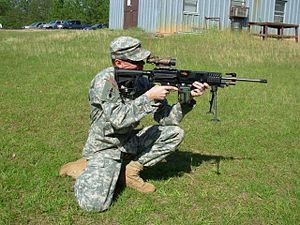LSAT light machine gun
| LSAT light machine gun | |
|---|---|
|
A U.S. Army soldier performs a test shooting of a prototype cased telescoped light machine gun in 2010.
|
|
| Type | Light machine gun |
| Place of origin | United States |
| Production history | |
| Designer | AAI Corporation |
| Designed | 2003 onwards |
| Manufacturer | TBD |
| Unit cost | ≤US$3600 |
| Produced | Earliest: 2010 |
| Variants |
Cased telescoped ammunition firing variant Caseless ammunition firing variant |
| Specifications | |
| Weight | 9.8 lb (4.45 kg) empty (cased telescoped variant) 9.9 lb (4.5 kg) empty (caseless variant) |
| Length | 36.1" (917 mm) (stock retracted) |
| Barrel length | 16.5" (418 mm) standard 12.5 in (320 mm) compact |
|
|
|
| Cartridge |
Cased telescoped ammunition LSAT caseless ammunition |
| Caliber | 5.56 mm (at present) |
| Action | Gas-piston; push-through feed-and-ejection; open, swinging chamber |
| Rate of fire | ≈650 rounds/min |
| Muzzle velocity | 920 meters/sec |
| Effective firing range | ≈1000 m |
| Feed system | 100 (cased telescoped) or 150 (caseless) round soft pouches of full-loop-polymer linked, disintegrating belts |
| Sights | optical, future variants to include advanced tracking and acquisition |
The LSAT light machine gun, of the LSAT (Lightweight Small Arms Technologies) program, is a developmental, powerful light machine gun (LMG). The purpose of the program was to develop a lighter, yet very reliable LMG. The program was initiated in 2004, when the Joint Service Small Arms Program (JSSAP) challenged the American defence industry to develop a lighter small arms and also design lighter ammunition. The LMG provides a major reduction in weight over legacy weapons, as well as improvements in other areas, such as controllability and reliability. As of 2008, it had two configurations, one that fires cased telescoped ammunition, and one that fires caseless ammunition. After further research and development into both technologies and the guns that fire them, one of the two variants was to be chosen for production. By May 2015, 85,000 cased-telescoped rounds had been fired through 10 test weapons, with testers claiming the weapon had gone as far as it can go until the Army decides if it wants to make it a program of record.
Development began with the two types of weight-reducing ammunition, and a light machine gun to serve as a testbed and technology demonstrator. Use of an LMG for this purpose is notable, considering its greater technical complexity than infantry rifles. The use of advanced computer simulations to accelerate development may have mitigated this, and the less significant LMG succeeds at being less conspicuous to unwanted media attention. For development, the use of extensive computer simulation and modelling reduces both time and expenditure for prototyping and testing. The program also uses a 'spiral development' approach, whereby the weapon and ammunition is rolled out in stages or 'spirals', each stage producing a new version that is an improvement on those from previous spirals. A competition down-selected the design concepts of various companies to leave an AAI Corporation-led team of companies as the developers of the weapon system. The cohesive team of companies is combined with government support to ensure success. The parallel development of the two ammunition types meant that, if the caseless ammunition effort succeeded, much of the development work gained with the composite cased weapon could be applied to it, and, if it failed, the composite-cased version was likely to succeed on its own.
...
Wikipedia

